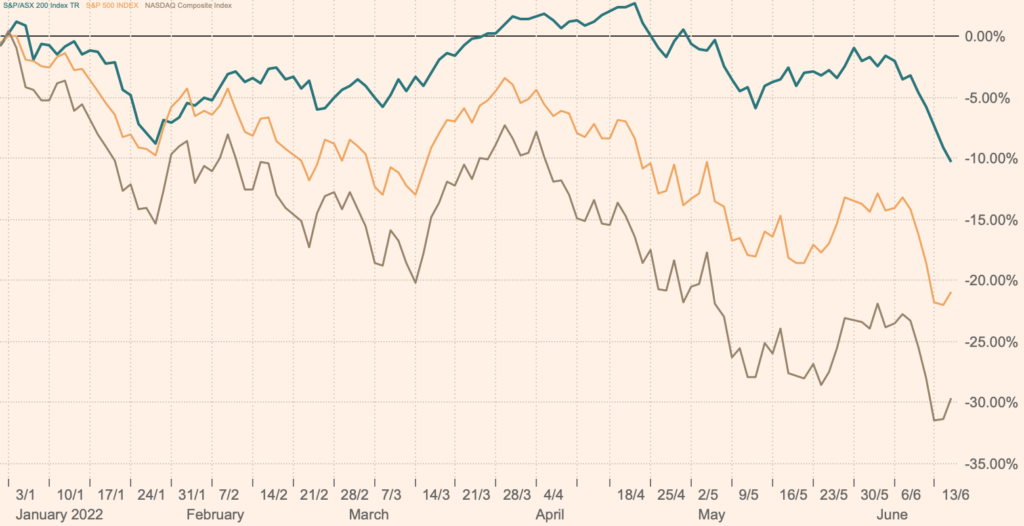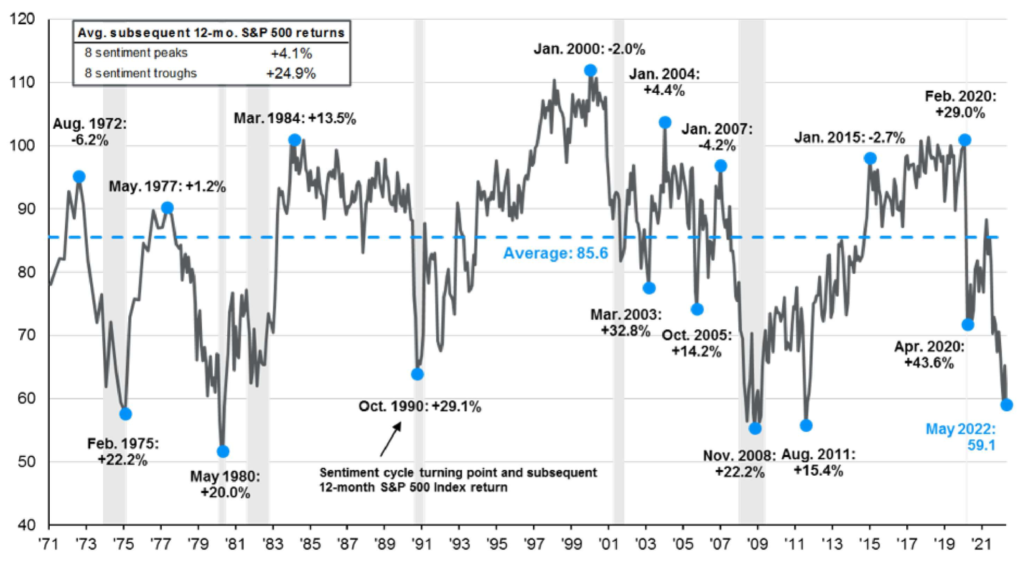Well, what a difference six months make.
I wrote a post earlier in the year to outline the strong share market and property returns everyone enjoyed in 2021. Interest rates were low, there was no war, property and shares were performing well, and inflation wasn’t an issue. Feels a bit different now, doesn’t it!
The reason for this post is to try to allow you to look past the current noise and continue to focus on your long term objectives, not the 24-hour news cycle.
Since the start of the year (6 months), as shown in the graph below (Source: Financial Times):
- The Australian share market (green line) is down around 10%.
- The broad US share market (orange line) is down around 20%.
- The technology focussed US share market, as measured by the Nasdaq index is down 30% (Brown line).

It is often in times such as these that the greatest buying opportunities present – as history has shown.
I recently reviewed a research paper from JP Morgan, which looked at 50 years of consumer sentiment and US share market returns, and it confirms that the best future returns are often made when things seem the worst.
The following graph (Source: JP Morgan) shows consumer sentiment measured on the left axis, with blue dots indicating when sentiment was at a peak or trough. There have only been 4 other periods in the last 50 years where US consumer sentiment has been lower, and in each of those 4 periods the share market produced very strong returns in the following 12 months (averaging 20% in each period).
Consumer Sentiment Index and Subsequent 12-month US Share Market Returns

Interest Rates
The other big news is interest rates – the US federal reserved increased its official interest rate by 0.75% last night – the highest single increase since 1994. Domestically, the Australian cash rate has also increased by 0.75%, albeit via two increases rather than the one. It is almost universally acknowledged that rates will continue to increase, and banks current longer term fixed rates are also indicating this is the case. I can’t predict how much interest rates will increase by, but what I found very interesting this week is that we had the Governor of the Reserve Bank, Philip Lowe being interviewed on the 730 report.
It is very uncommon for the head of the RBA to appear on a current affairs show, and the message relayed to the viewers during the interview was that the RBA felt inflation was heading towards 7% and it should ideally be somewhere between 2-3%. Given interest rate increases are usually the main trigger used to curb inflation – these comments may offer us all some indication for future interest rate movements. Full interview (15 mins) in link below if you are interested.
If inflation does increase to 7%, as is being predicted by the RBA, then those investors deciding to stay in cash to protect their capital are sadly going backwards post inflation. Term Deposit investors should always remember that inflation should be seen as the mouse nibbling away at the real value of your capital – seemingly very small bites, but over time, they are significant. With inflation running hard, those with big cash holdings now have a few more mice to contend with!
In Summary
for those with a medium- to longer-term investment horizon, it is my feeling that now may well represent an opportune time to purchase shares at a lower price. As always, if you wish to discuss how current events may be impacting your portfolio or any other matter, please get in touch.
Please feel free to call me directly on 0438 383 513 or book in a time here: https://bpmfinancial.com.au/book-an-appointment
Information provided in this blog post / newsletter is general in nature and does not constitute financial advice. Please review our General Advice Disclaimer here: https://bpmfinancial.com.au/general-advice-disclaimer/